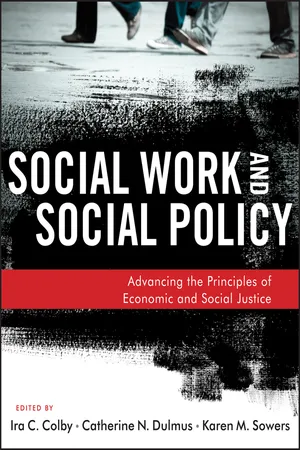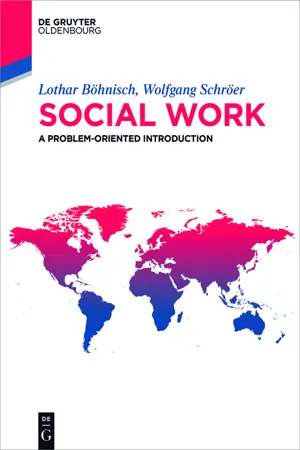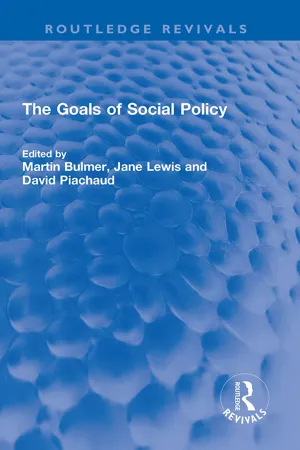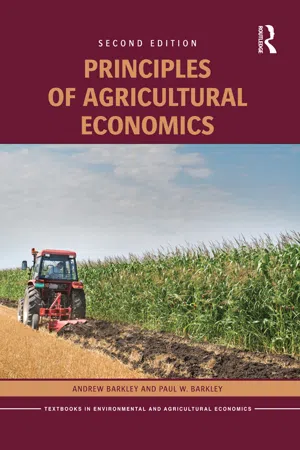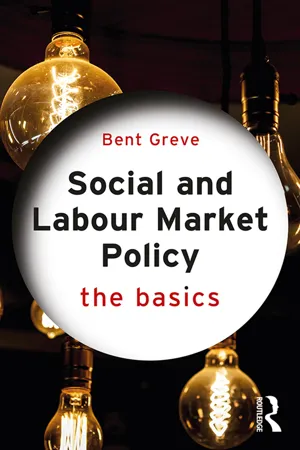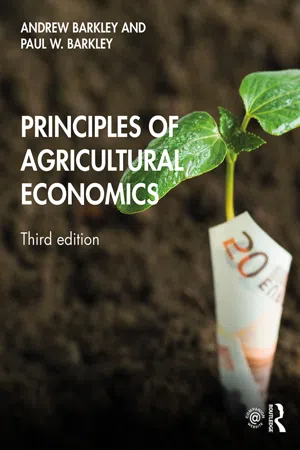Economics
Social Welfare Policy
Social welfare policy refers to government programs and initiatives designed to promote the well-being of society by providing assistance to individuals and families in need. These policies often include programs such as unemployment benefits, food assistance, healthcare, and housing support. The goal is to address poverty, inequality, and social challenges through targeted interventions and support systems.
Written by Perlego with AI-assistance
Related key terms
Related key terms
1 of 4
Related key terms
1 of 3
11 Key excerpts on "Social Welfare Policy"
- eBook - ePub
Social Work and Social Policy
Advancing the Principles of Economic and Social Justice
- Ira C. Colby, Catherine N. Dulmus, Karen M. Sowers(Authors)
- 2012(Publication Date)
- Wiley(Publisher)
Policy creates a community's context of justice in how it approaches the provision of social services. Public and private organizations, nonprofit and voluntary associations implement policies, which in turn are “experienced by individuals and families” (Jansson, 1999, p. 1). Similarly, policy is vital to the social worker by specifying the type and level of service the practitioner is able to provide. Policy is a formal statement articulating rules and regulations that reflect values, beliefs, data, traditions, discussions, debates, and compromises of the body politic. Policy carries out multiple functions, ranging from crafting the broad framework in which a program or service evolves to detailing the available services.Social welfare policies, which are a subset of the broader social policy arena, focus on issues that are controversial and the epicenter for many debates. Discussions on radio call-in shows and television panel shows are replete with welfare matters, ranging from immigration and border issues to women's health care and reproductive rights. The 2012 presidential primary race was filled with attacks on social issues and policies directed to amend the growing inequalities faced by the young and old and, in particular, women. Sadly, the tenor of the arguments and controversies themselves are not new. Throughout American history, political leaders have staked out their positions relating to welfare, such as the following:- Benjamin Franklin: “I am for doing good for the poor, but I differ in opinion about the means.… The more public provisions were made for the poor, the less they provided for themselves and the poorer they became.… On the contrary, the less that was done for them, the more they did for themselves.” (The Writings of Benjamin Franklin)
- President Franklin Roosevelt: “The Federal Government must and shall quit this business of relief. I am not willing that the vitality of our people be further sapped.… We must preserve not only the bodies of the unemployed from destitution but also their self-respect, their self-reliance and courage and determination.” (State of the Union address)
- President John F. Kennedy: “Welfare…must be more than a salvage operation, picking up the debris from the wreckage of human lives. Its emphasis must be directed increasingly toward prevention and rehabilitation.… Poverty weakens individuals and nations.” (Woolley and Peters)
- eBook - ePub
Soziologie - Sociology in the German-Speaking World
Special Issue Soziologische Revue 2020
- Betina Hollstein, Rainer Greshoff, Uwe Schimank, Anja Weiß(Authors)
- 2021(Publication Date)
- De Gruyter Oldenbourg(Publisher)
Marshall (2000 [1950]), it is common to conceptualize the institutionalized relationship between the state and the citizen as “social citizenship.”Since social policies are part of the macro level of society, the primary focus of social-policy research is on cross-national or cross-regional differences and on historical change in social policies (Obinger et al., 2013 ). Sociologists mainly contribute to this by theories and research on the trends and social consequences of social policies. They also analyze the cultural, socio-structural, and demographic factors that can explain these changes. Sociological theory and research have shown that the degree of redistribution of financial resources by welfare states and their generosity towards those who are temporarily not employed (sick, disabled, unemployed, and retired persons as well as those who care for family members) are crucial for explaining the degree of inequality, poverty, and social cohesion in a society. It seems that generous welfare states that take an inclusive approach to social citizenship create the most favorable conditions for a more egalitarian social structure along with greater social inclusion and social cohesion (Esping-Andersen, 1990 ).Particularly important to research on the relationship between welfare-state policies and social structures was GöstaEsping-Andersen’s The Three Worlds of Welfare Capitalism (1990). According to his “welfare regime” approach, it is possible to distinguish between different ideal types of welfare regimes: the liberal, conservative, and social-democratic (Esping-Andersen, 1990 ). The main criteria for the construction of this typology are (a) the degree of generosity in granting social rights related to social security, which is indicated by the extent of “de-commodification”; (b) the ways in which welfare-state policies affect the structures of social inequality; and (c) the relative weight of the state, the market, and the family in the provision of social services. According to this approach (Esping-Andersen, 1990 ), the social-democratic welfare regime is ideal-typically based on a high degree of de-commodification, supports egalitarian social structures, and assigns the state the role of the main welfare provider. The liberal type has a low degree of de-commodification, encourages social polarization, and positions the market as the main provider of welfare. The conservative welfare regime, by contrast, has a medium degree of de-commodification by linking social security to paid employment, fosters hierarchically segmented stratification, and renders the family the main provider of welfare. Some authors have suggested extending this typology to include a Mediterranean (Ferrera, 1996 ) and Central-Eastern European (Fenger, 2007 - eBook - ePub
- Lothar Böhnisch, Wolfgang Schröer(Authors)
- 2016(Publication Date)
- De Gruyter Oldenbourg(Publisher)
10Social Work and Welfare PolicySocial work and welfare policy are closely interlinked. In this context, social work is seen as a living inventory of social policy. While social policy relates to social protection against standardized risks such as illness, unemployment and poverty, social work deals with the various biographical results and side effects of these risks, as well as individuals’ other psychosocial problems. Until now, the welfare state has been the central institution for the social policy of most European countries. However, an examination only of state activities and the responsibilities they directly and indirectly delegate to municipalities and associations is not enough to gain a picture of social work’s true socio-political environment. Looking merely at civil society activities or the social services and nursing market, which complements the state sector while also being privately operated, there is talk of a “welfare mix” where social work needs to find and form networks, mainly within the region and the municipality.Here, social work complies with the terminological distinction made by Franz-Xaver Kaufmann (2003), who sees socio-political tasks as including not only the legal and economic field of social policy (legal equality, transitional employment services, the equalization of burdens and social spending) but also the field of social infrastructure development (including social work services) and pedagogical intervention.The welfare state has developed within the boundaries of each nation state. Over the process of globalization, these borders have started to crumble; national welfare states have lost their power to shape the system. This has also affected the opportunities and limits of social work, as an agency belonging to the welfare state. For this reason it needs to rethink its welfare policy; it requires socio-political reflexivity - eBook - ePub
Social Policy for Effective Practice
A Strengths Approach
- Rosemary Kennedy Chapin, Melinda Lewis(Authors)
- 2020(Publication Date)
- Routledge(Publisher)
CHAPTER 4 The Economic and Political Contexts S OCIAL WORKERS HELP PEOPLE IN NEED. In many cases, this need has economic dimensions. The economy determines what people pay to secure basic goods, the opportunities they find in the labor market, and the distance that separates them from others. In a society, however, dollars and cents are not the only calculations that matter. The political environment shapes the policy outcomes considered acceptable and the resources available to meet people’s needs. For example, politics are at work in outlining the social welfare programs voters are willing to support and the requirements imposed on those seeking assistance. Effective policy practice requires understanding how economic and political contexts influence U.S. social policy and, therefore, our ability to help our clients. Examination of the historical context of social work made clear that economic fluctuations and political change interact with shifting social values and changing demographics to determine U.S. social policy. Developing the critical-thinking skills to analyze how these elements are woven together is vital for you to become an effective social work policy practitioner. The ability to scan and navigate political and economic landscapes is an essential part of promoting economic justice, where all members of a society have sufficient opportunities to obtain the material resources necessary to survive and to fulfill their human potential (Barker, 2014). The process of developing and implementing social policy is strongly influenced by political and economic interests. The economic context of social policy focuses on the production, distribution, and use of resources, while the political context focuses on the pursuit and exercise of power in public affairs. Although these terms have distinct meanings, they are often enmeshed - eBook - ePub
Welfare State and Welfare Society
Illusion and Reality
- William Robson(Author)
- 2018(Publication Date)
- Routledge(Publisher)
Chapter VIIEconomic Policy in the Welfare State
Government intervention in the economy is ubiquitous and is of major significance, even in countries that cannot be classed as welfare states. It is, indeed, virtually impossible today to find a government which follows a laissez-faire policy. I shall endeavour in this chapter to show what economic policies are conducive or necessary to the promotion of welfare and to distinguish them from those which can only be justified on other grounds.We have already noted in an earlier chapter that social insurance and social assistance are two of the most important social services. But they do no more than meet the needs – and often only the bare subsistence needs – of individuals when they are suffering from the common vicissitudes of life, such as unemployment, sickness, invalidity, widowhood or orphanage. The limited value of income-maintenance devices to deal with mass unemployment, on the scale which occurred during the great depression in the years between the two World Wars, led to a policy of full employment being adopted by the wartime coalition government.The avoidance of massive unemployment is clearly a welfare objective when we consider the misery, hardship and waste of human resources caused by prolonged unemployment. When the policy of full employment was adopted, the question of how it relates to inflation was not perceived. High rates of inflation have become widespread in recent years and there is much controversy among economists about the causes. No government has so far managed to achieve full employment without producing a high rate of inflation, and no economist has proposed a remedy for inflation which will not inter alia cause a substantial increase of unemployment.No one would suggest that a welfare state must choose between unemployment and inflation stated in these crude terms. The only sensible approach would be expressed in quantitative terms; for example, how much inflation is acceptable in order to avoid unemployment above a specified level, or how much unemployment would be tolerated in order to keep inflation below a certain figure? I do not intend to suggest the answers to this difficult question, but the following observations may be relevant. The two evils of unemployment and inflation do not necessarily afflict the same persons, or at least not to the same extent. Unemployment may hit a particular industry or group of industries more than others, or it may affect certain areas of the country. The older and more infirm workers, immigrants, and the less competent, are likely to suffer most. Inflation causes most hardship to pensioners and persons on fixed incomes, to women in one-parent families, to workers in the unorganised industries, and to those in occupations which cannot bring much pressure to bear on the economy. Contrast in this respect the position of dockers or railwaymen with those of kitchen porters or hairdressers, for example. - eBook - ePub
- Martin I A Bulmer, Jane Lewis, David Piachaud, Martin I A Bulmer, Jane Lewis, David Piachaud(Authors)
- 2022(Publication Date)
- Routledge(Publisher)
The period in question coincides with the advent of capitalism and the creation of a fully fledged market economy. The turn taken by economic development leading to the prevalence of market and profit interests has certainly harmed many other interests. For example, many elementary human, communal and societal needs were squeezed out from being legitimately acceptable on the grounds that the necessary purchasing power was lacking. The coverage of the needs rejected by the market necessitated new forms of social organization. This was in line with the separation off, and relative autonomy, of the sphere of social reproduction. Thus the field of social policy or social welfare emerged, and has gradually become institutionalized.The social welfare sphere has evolved in constant interaction with the political and economic spheres. Because of profound, farreaching changes in all spheres the whole character of society has considerably altered. In consequence, besides an almost continuous expansion of the welfare sphere, there emerged different historical social policy configurations.Some of the basic processes which affected social policy are worth mentioning. With economic growth more resources could be used forFigure 18.1Configurations of social policy in mixed societiesobjectives that were not immediately ‘productive’; that is, the scope of non-market activities could expand. It also became clear that the majority of the activities having no immediate economic purpose after all served the economy: increasingly complex industrial technologies required workers with more culture, more education and more autonomy. Sheer waste of human resources had also to be stopped because of decreasing fertility — again, partly also in the interest of the economy. With many other social and political changes, the working class has changed from a class ‘in itself’ to a class ‘for itself’, and became a strong political factor. The system of political institutions has to accommodate these and other movements of political emancipation. In a relatively short time these movements started to request not only more resources but also a different system of access and delivery more in line with human dignity. Thus the character of the rights - eBook - ePub
- Andrew Barkley, Paul W. Barkley(Authors)
- 2016(Publication Date)
- Routledge(Publisher)
lo and Q*. Interestingly, if area B is larger than area C, consumers as a group are made worse off by the price ceiling intended to help them. This is possible when the demand is highly price inelastic, and supply is relatively price elastic. Therefore, the success of the policy depends on the own-price elasticities of supply and demand.Welfare economics is a powerful and useful tool to quantify, analyze, and evaluate government policy proposals and market changes. Calculation of changes in the dollar value of well-being for all affected groups provides a solid contribution to policy analysis and decision making. One important feature of welfare analysis is the identification and quantification of policy consequences, both intended and unintended.11.3 Macroeconomics
As we learned in Chapter 1 , macroeconomics is the application of economic principles to “economy-wide aggregates,” meaning issues, policies, and events at the national or international level. Macroeconomics is broad, general, and impacts the entire economy. Therefore, macroeconomics affects all individual production and consumption decisions, often unnoticed, in the background in ways that may not be obvious. Knowledge of macroeconomics provides a useful and powerful tool for economic decision making in food and agriculture. In this section, a broad overview and description of basic macroeconomic principles is provided as a brief introduction to the fascinating and impactful study of the overall economy.Macroeconomists use the same approaches as microeconomists, including cost–benefit analysis, marginal analysis, and measurement of value and well-being in currencies such as dollars and Euros. However, macroeconomics is often used to better understand the overall function of the economy, and provide forecasts of future business climate, economic growth, and the value of currencies.11.3.1 Macroeconomic basics
Macroeconomics seeks to measure, understand, and forecast the overall value of a national economy. The most common measurement of the overall size of the economy is Gross Domestic Product - eBook - ePub
Social and Labour Market Policy
The Basics
- Bent Greve(Author)
- 2018(Publication Date)
- Routledge(Publisher)
3.7. Summing upSocial policy is not the same across countries, including differences in how much money is spent on welfare and on what types of social policy there are and how generous the benefits are. However, there are some common elements and discussions in most countries. These are discussions revolving around the level of benefits, who is eligible for benefits and under what conditions. Behind this is often an (albeit mainly implicit) understanding of who is deserving and who is not deserving of different types of social benefits.All countries also have some degree of inequality and some people living in poverty, or as labelled in the EU, at risk of poverty. There are issues and difficulties in measuring both poverty and inequality; however, if measuring it in the same way over time and across countries, it informs about the difference, development and levels hereof. Whether one, as a consequence of the level of poverty or inequality, would make a public sector intervention and decide new social policy issues is, at the end of the day, a political decision. Recent years have seen an increase in inequality and poverty in many countries. The generosity of income transfers can be an important element in the size and degree of inequality, but also the way the tax system influences the level of inequality. In-work poverty, or working poor, is an issue that has increased in recent years.There are old and there are new social risks – and this will, presumably, continue to be the case. Old risk relates to four classical aspects: old age, sickness, unemployment and work injury. The distinction is perhaps not in itself important in order to understand social policy, but it is important as a way of being able to grasp how new types of systems develop, what kind of needs might arise and that there can be a need for state intervention in order to support different groups of people. The work–family life balance is an example of an important new social risk. This as most people in the working age would like to have a job, but they would also like to have a family, including children. If, for example, there are not day-care institutions or they are very expensive, this might make it difficult to combine this. - eBook - ePub
- Ian Neary(Author)
- 2019(Publication Date)
- Polity(Publisher)
In every society, welfare provision comes from a variety of sources: the home, the profit-making sector, the non-profit sector (i.e., volunteer groups and charities) and the state. Most health care, at least primary health care, is provided in the home. In pre-modern societies the rest came from health professionals who were paid for their services, with a small amount coming from non-profit organisations such as religious bodies. Little or nothing came from the state. Welfare in old age was not a major problem until the twentieth century as few people survived beyond the age of forty, but it then became a responsibility that was increasingly taken on by the state, although private provision has always been important. This ‘mix’ – how much welfare is provided by each sector – differs from society to society, from one sector to another, and perhaps even between social classes or groups. It may vary over time and, indeed, it may be an object of policy to shift the balance within the mix. In this sense, each country can be said to have a social welfare system characterised by a unique mix.All decisions about welfare should start from the principle that a particular action or policy should not produce greater injustice than the one it is intended to reform or replace – ‘first do no harm’. This sounds fine, but it is difficult to put into operation given that democratic governments often have to balance one set of short-term consequences against those of the medium to long-term. Should social policy simply be about ‘safety nets’, below which no citizen be allowed to drop? If so, how low should the safety net hang? Or should the state regard social welfare as a tool for income redistribution, so that the wealthy are taxed to provide resources for the worst off in order to create a just society?This chapter will briefly outline the historical background to welfare policy in Japan and then critically review the nature of the provision in three sectors – health care, pensions and social services – and the recent changes in policies towards them.Some background history
Welfare policy in the late nineteenth century took on some modern aspects, but only in so far as it was devised largely as a response to, or in order to preempt, social unrest, and not from a desire to provide minimum standards of living for Japanese citizens. The regulation of poor relief in 1874 was a reaction to popular unrest, and amounted to little more than an institutionalisation of the meagre welfare structures developed in some feudal local government units. In the later 1890s, journalists started to ‘discover’ the urban poor and, not coincidentally, the first glimmers of a socialist politics began to appear. The number of people involved in these embryonic socialist groups was tiny, but still enough to worry the ruling elite who feared that if left alone they would create a large social movement able to threaten the stability of the state, as had happened in several European countries including Bismarck’s Germany. Therefore a ‘social policy’ was developed which consisted of measures to restrict the development of the socialist movement, as well as some welfare provision. The most obvious example of this policy was in 1910–11, when twenty-two socialists and anarchists were arrested and eleven executed for allegedly plotting to assassinate the emperor. Soon after, hospitals were set up to provide free health care for the poor, funded in part by a ¥1.5 million donation from the imperial family (Garon 1997: 48). The Saiseikai (Imperial Gift Foundation) still exists and supports 379 medical facilities, including seventy-nine hospitals, many of them in the most deprived areas. - eBook - ePub
- Andrew Barkley, Paul W. Barkley(Authors)
- 2020(Publication Date)
- Routledge(Publisher)
Chapter 11 Government policiesPhoto 11.1 Government policiesSource: M DOGAN/ShutterstockAbstract
Price policies, including price supports and price ceilings, are analyzed, with real-world examples highlighting the consequences of agricultural price policies in low-income and high-income nations. Welfare economics is used to understand how producer and consumer well-being changes in response to changes in policies, markets, and current events. Labor immigration is analyzed to find who gains and who loses from a nation accepting new workers into the workforce. Macroeconomics, the study of economy-wide features such as inflation and unemployment, is introduced. Monetary and fiscal policy are described, and their impacts on the agricultural sector detailed. Food security, hunger, global poverty, and economic development are outlined, and public goods are comprehensively explained.11.0 Introduction
Market economies have many advantages, including efficiency and a high standard of living. However, all real-world economies are mixed economies, with large and important roles for government programs and policies. Governments provide numerous important functions, even in the most free-market economy: the provision of law and order, public safety, national defense, education, research and development, health initiatives, and environmental protection, just to name a few.Economic programs include investments in infrastructure, research, and protection of some industries from foreign completion or market-based challenges. The government also conducts macroeconomic policies, which include fiscal and monetary policies intended to promote the functioning of the overall economy.Agriculture in the United States, and most nations, is characterized by heavy government intervention. Governments provide many programs and policies to ensure the provision of a sufficient, safe, and nutritious food supply. So far, this book has emphasized the benefits and advantages of markets: whatever goods that consumers desire are supplied by producers at the lowest possible cost. Competitive markets ensure that consumers have access to the goods and services that provide the greatest level of utility. Market-based economies, however, require government intervention due to “market failures,” or situations where markets provide undesirable outcomes. - eBook - ePub
Social Policy for Effective Practice
A Strengths Approach
- Rosemary Kennedy Chapin, Melinda Lewis(Authors)
- 2023(Publication Date)
- Routledge(Publisher)
Social Welfare Spending In the United States, “welfare” initially meant well-being (Katz, 2008), as in the U.S. Constitution’s reference to the promotion of the general welfare. When social welfare is defined broadly, most social welfare expenditures are not targeted toward low-income people. However, even though most Americans benefit from the social welfare system in substantial ways (Abramovitz, 2001), biases obscure many of the roles social welfare programs play in our own lives (Howard, 1997 ; Mettler, 2010). Instead, the popular definition of “social welfare” is often limited to assistance for people categorized as “needy.” This narrow framing contributes to people’s resistance to invest in public social welfare programs they do not perceive as benefiting “people like them,” while minimizing the substantial role policy plays in facilitating the well-being of those already advantaged. For example, when people identify social welfare expenditures, they are more likely to think of subsidized housing than mortgage interest deductions, even though both types of spending are directed at meeting people’s housing needs. Crucially, while they serve similar ends, programs directed primarily at people with higher incomes are often more strengths-based than those aimed at low-income people; the former, for example, encourage asset-building and place people in control of their own decisions, while the latter are more tightly controlled (Elliott & Lewis, 2018). Using a more comprehensive definition of welfare helps draw attention to what has been termed “the upside-down welfare state” (Abramovitz, 2001, p. 298), where more substantial and valuable assistance is provided to those with the least need. It also helps us understand why welfare spending does not make a bigger dent in inequality
Index pages curate the most relevant extracts from our library of academic textbooks. They’ve been created using an in-house natural language model (NLM), each adding context and meaning to key research topics.
Explore more topic indexes
Explore more topic indexes
1 of 6
Explore more topic indexes
1 of 4
